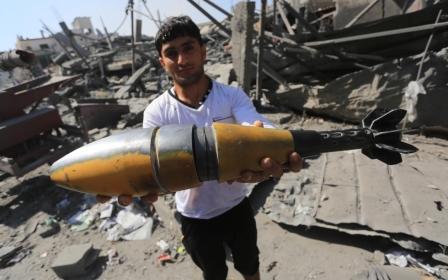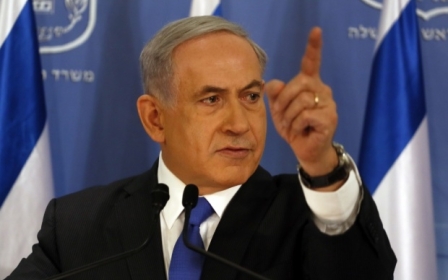Nowhere to hide in Gaza

GAZA CITY- “Netanyahu has turned our homes into ruins and our neighborhoods into ghost towns,” says Anaam Bannar, a 56 year-old homeless Palestinian.
Bannar has nowhere to go, except Rafdeen school to seek shelter - but even schools are targeted by Israel. Ten days ago, her home was razed to the ground by Israeli tank shells. When she cautiously returned during a 12-hour ceasefire, she didn’t recognize the location or house, and no familiar landmarks were left to identify exactly where she was.
More than three weeks of horror and trauma fill the hearts and minds of people in Gaza- those who are lucky enough to be alive have still lost everything and have no safe-haven from Israel’s heavy military bombardment. The whole of Gaza is in the crosshairs.
“You can run in any direction,” she says “and you are still a target, because you are Palestinian. In the 2008-9 Israeli war on Gaza-translated as “Operation Cast Lead,” Bannar lost her husband and four sons in a massacre, which brought immense sorrow to her family. Now, her home is demolished and she still questions why she should be targeted.
For 56 year-old Inshirah Abuelkas, it is difficult to contemplate what Israel considers to be a target, as she has no affiliation or connection to the resistance or militants - she just lives in Gaza.
“Israelis are failing to reach the resistance fighters, so they punish all civilians instead, and bomb our homes, families and children.”
She tells how she ran away from Israeli mortars in Shejaia-fleeing to a new shelter at al- Rafedeen School in Gaza City. But even here in the school with her family, they can’t escape the attacks and her children are still chased by gunfire.
“And where do we go in September when schools are due to open?” A neighbor speaks up and suggests, “we only have the beach to run to…” before another person interrupts her, “No, remember what Israel did killing four children on the beach, firing missiles at them, from navy warships?”
“In the dark night, as the drones hover, we are hit by Israeli warships, then in daylight, by FI6’s,” she says.
The debate on safety turns full circle with no-one knowing of any safe place to shelter, be it homes, schools, hospitals, parks, cemeteries, beaches, mosques or churches. All areas are being bombed by Israel.
“The option that we surrender and leave completely is not on our Palestinian ‘table.’ This is our land, our home; we belong here and will stay.”
A few days ago, Israel bombed another UNRWA school; a UN-designated “safe haven,” killing at least 16 people and injuring hundreds of civilians who sheltering there after being ordered by Israel to leave their homes.
The UN reports that 215,000 Palestinians - more than 10% of Gaza’s population - are now seeking shelter in UN facilities, as well as in schools and with their relatives. UNRWA spokesman in Gaza - Chris Guinness - broke down in tears, when being interviewed on international media yesterday.
As a wife and mother to 12 children, Abuelkas says she cannot think of any safe place to go. The constant threat from Israel and lack of security means she counts her children every few minutes to make sure none have wandered out of the fragile refuge of the school.
The UN reports that 133 schools have been targeted by Israeli tank shells. Gaza is a small piece of land, tightly packed with 1.8 million civilians - considered to be the most overcrowded residential area on the planet where, because of Israeli occupation of all borders and air-space, there is no option to even flee to neighboring countries. Shooting fish in a bowl!
Buffer zone
The coastal enclave is a tiny strip of land 41 kilometers (25 mls) long and 6 to 12 kilometer wide (7 to 7.5 mls). To the east, Gazans are fenced in by Israeli artillery tanks, mortars, cannon shells and snipers, to reinforce a now-wider “buffer zone.” To the west, Gazans face Israeli warships and just a 3-mile fishing zone at best, when things are relatively calm. At the northern border with Israel is another military buffer zone and checkpoints. And south, in Rafah, Gaza is also closed off by the Egyptian military, per the orders of the Israeli government.
Israel has declared a “buffer zone” of three kilometers inside Gaza’s borders with Israel – which, given Gaza’s tiny size, represents 44% of Gaza’s territory – in which anyone present is deemed to have been duly warned to leave or bear all lethal risks arising from their presence.
Israel’s kill toll now stands at 1730 Gazan people and 9200 injured. This has surpassed Israel’s kill haul of 1,417 dead Palestinians during Operation Cast Lead (2008-9).
Abuelkas says, “even if we try to find a “safe haven” before they die, we are all still being targeted.”
Those who have disabled children now fear sending them to rehabilitation centers, after several health centers were targeted.
Abuelkas says Israelis have bunkers to hide in, but here we don’t, expect a mothers arm - but even that is a language or concept Israeli military does not seem to understand, or care about.
“We are asking our Arab brothers and sisters to stand by us and support us. We feel abandoned by them”.
Stay informed with MEE's newsletters
Sign up to get the latest alerts, insights and analysis, starting with Turkey Unpacked
Middle East Eye delivers independent and unrivalled coverage and analysis of the Middle East, North Africa and beyond. To learn more about republishing this content and the associated fees, please fill out this form. More about MEE can be found here.




